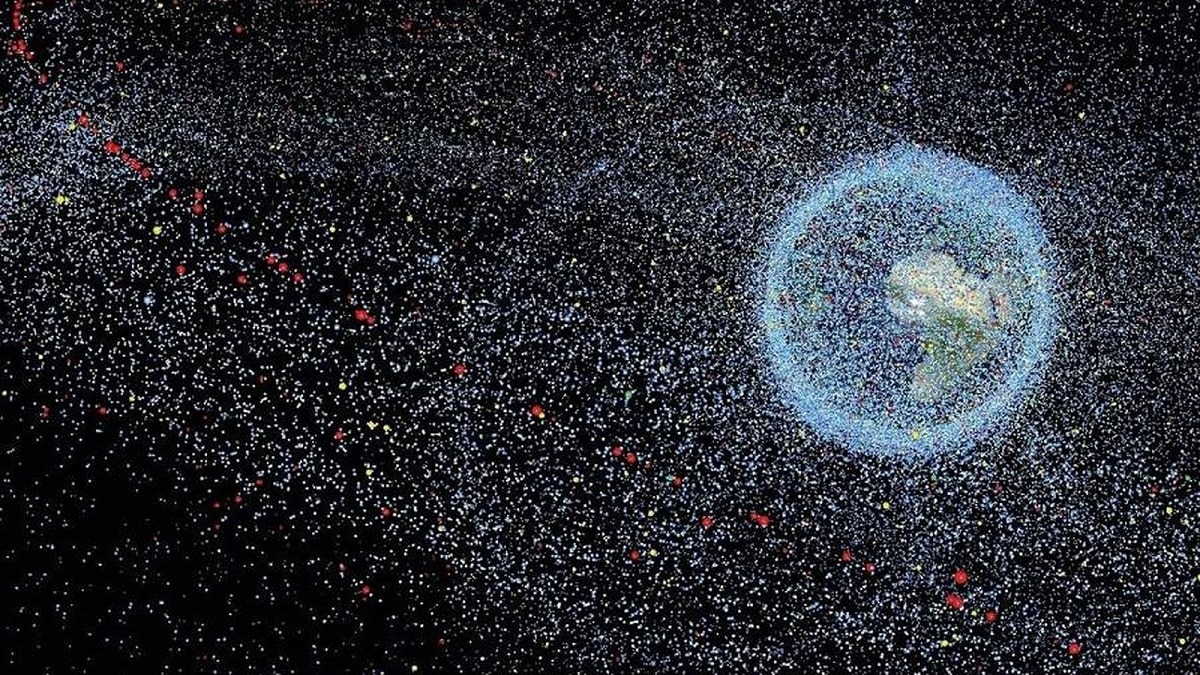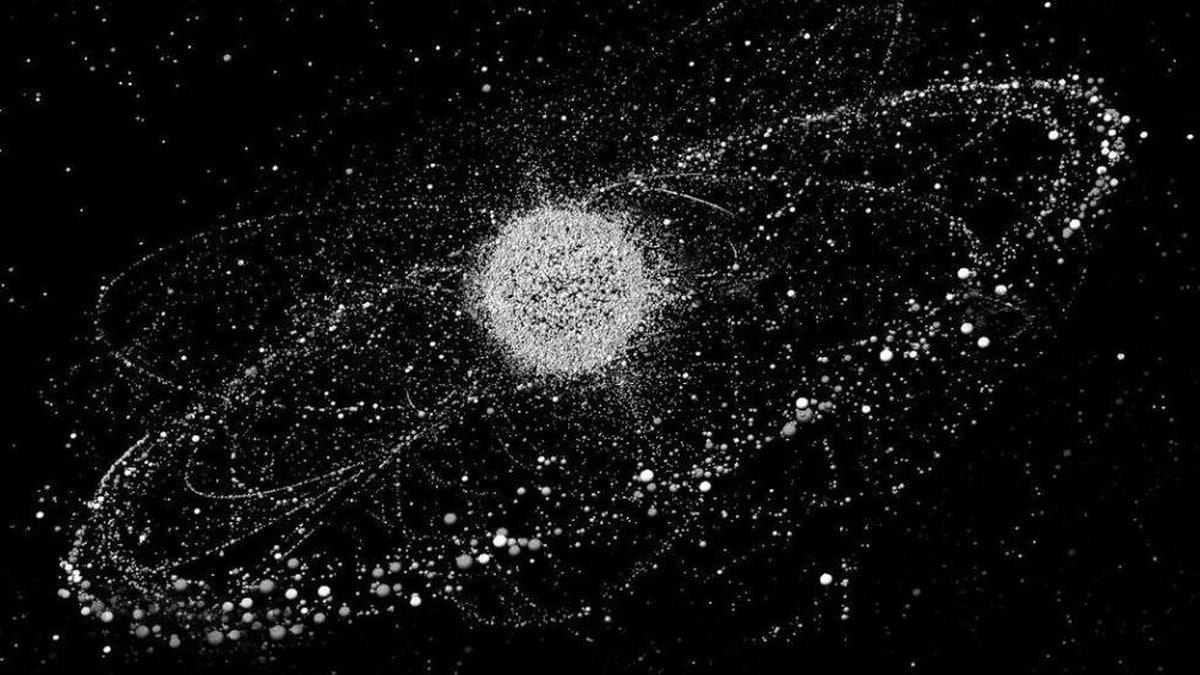
Space junk or space debris is any machinery or debris left behind by humans in space. It can refer to large objects, such as dead satellites that failed or were left in orbit at the end of their missions. It can also refer to something smaller, such as a piece of debris or a piece of paint that fell from a rocket. Many people don't know what is space junk.
In this article we are going to tell you what space debris is, what its characteristics are and what consequences it has.
What is space junk

When we talk about space we usually think of spaceships, satellites and rockets, but have you ever thought about the garbage they produce? Where does the waste from space missions end up? Space debris is all debris thrown up and left behind by humans in space. These debris originate on Earth and can vary in size, from a drop of rainwater to the volume of a vehicle or even a satellite.
This debris travels at high speed and remains in Earth's atmosphere for years until it disintegrates, explodes, collides with other elements, or falls out of orbit.
It wasn't until the late 1950s that humans began launching rockets and spacecraft into space. At the time no one wondered what would happen when their useful lives ended.
Currently, there are bits and pieces around our orbit and those of other planets that pose a danger to communications and ongoing missions on Earth.
types of space junk
The Spanish European Agency classifies space debris into three types:
- utility load. They are those parts of the moons that remain after collisions or due to physical degradation over time.
- The physical remains of past missionss are also the result of collisions or deterioration over the years.
- Lost items in missions. This is the case of cables, tools, screws, etc.
Due to the size of space debris, there is another classification:
- It measures less than 1 cm. It is estimated that a large number of fragments of this size exist, and most are difficult or impossible to find.
- It measures between 1 and 10 cm. It can be anywhere from the size of a marble to the size of a tennis ball.
- The size is greater than 10 cm. In this section you will find items and tools lost in previous missions, and even lost and decommissioned moons.
Causes of space junk

Space junk comes from:
- Inactive satellites. When the batteries run out or fail, they float aimlessly in space. At first, it was thought that they would be destroyed upon re-entry, but in high orbit this was found to be impossible.
- Lost tools. Some parts of the device are lost in space. In 2008, astronaut Stefanyshyn-Piper left behind a toolbox. A year later, she disintegrated upon contact with the atmosphere.
- Rockets or rocket parts
- In the 1960s and 1970s, both the United States and the Soviet Union experimented with anti-satellite weapons.
The biggest risks come from the smallest parts. Micrometeorites, such as paint residue or drops of solid antifreeze, can damage the solar panels of currently operating satellites.
There are also traces of space-solidified fuel, which is in danger of igniting. If this happens, the consequence will be the dispersion of pollutants in the atmosphere.
Some satellites are equipped with nuclear batteries, which contain highly radioactive materials that could seriously contaminate the planet if they return to Earth. In any case, most space debris will decompose due to high temperatures after entering the atmosphere, and it is extremely difficult for debris to enter the atmosphere and cause significant damage.
Possible solutions
The main solution is not to generate this type of garbage. Whipple shields came into use, with an outer shell to protect the ship's walls from impact.
Some other resolutions:
- Orbit Variation
- Self-destruct satellite. It is about programming satellites so that, once their mission is completed, they can be destroyed upon reaching the atmosphere.
- Remove the satellite power supply to reduce the risk of explosion.
- Reuse those rockets that returned intact to the ground.
- Use the laser to stop the debris.
- Space debris turned into sustainable goods
In 2018, a Dutch artist, with the help of NASA and the support of the European Space Agency, was looking for ways to turn this debris into something sustainable and showed a space debris lab.
Consequences
According to ESA, there have been more than 560 debris incidents since 1961, most of which were caused by explosions of fuel present in rocket stages. Only seven have occurred due to direct collisions, the largest of which ended in the destruction of the defunct Russian satellite Kosmos 2251 and the active satellite Iridium 33.
However, the greatest risk comes from the smallest fragments. Micrometeorites, such as paint chips or solidified antifreeze droplets, can damage the solar arrays of active satellites. The other great risk is the remains of solid fuels, which float in space and are highly flammable, capable of causing damage and spreading pollutants into the atmosphere in the event of an explosion.
Some Russian satellites contain nuclear batteries that contain radioactive material that could become highly contaminated if it returns to Earth. In any case, most of the space debris that enters the atmosphere is destroyed by the heat generated during re-entry. In rare cases, larger fragments can reach the surface and cause extensive damage.
As you can see, humans have been polluting space since the beginning of space exploration. We not only generate garbage on the surface of the planet, but we are also polluting the space that we have not yet ruled. Hopefully awareness will increase so that all space missions include systems to recover all debris.
With this information you will be able to learn more about space debris and its consequences.
Super interesting topic... Which seems to go unnoticed by space scientists who know the danger to satellites and ships, but the solution in sight is remote. The new technologies necessary for progress are a harmful source for human and animal health and in general our mother nature, but we are blind, deaf and dumb, we pollute the oceans, soils, air and now the space with no SOLUTION in sight. When will we learn to prevent pollution?... As Descartes affirmed "I THINK, THEREFORE I AM" …Greeting